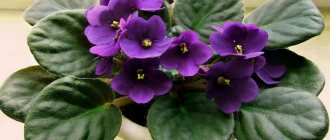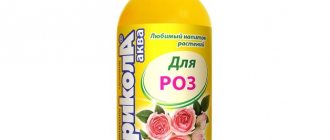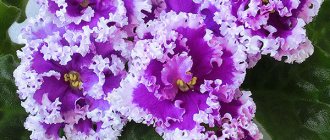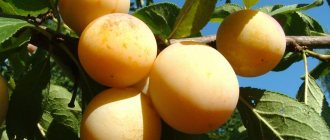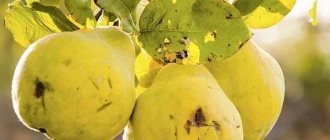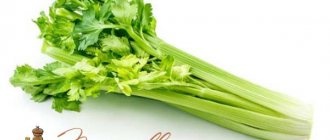Violet first appeared in pot culture at the beginning of the 20th century. The plant quickly gained popularity among flower growers around the world. The flower required very little care, but looked very beautiful during flowering.
It was soon discovered that violets are excellent for breeding work. New varieties and hybrids of flowers began to appear.
It is simply impossible to list even 0.001% of all bred varieties of Saintpaulia. In this article we will talk about the most interesting, from our point of view, varieties of violets and their classification.
Frosty Cherry
Gorgeous double cherry-scarlet flowers with white fringe will not only decorate any windowsill, but will also become a real decoration for your flowerbed or garden.
An interesting fact is that over time the flowers acquire a more saturated dark color, but from a lack of light, on the contrary, the flowers become lighter. This heat-loving variety does not tolerate cold, but it also has a hard time withstanding heat, and humidity is undesirable when growing Frosty cherries. If you follow all the rules for caring for your favorite flower, it will give you lush and long flowering.
Home care
An adult ampelous Saintpaulia does not require special attention and care .
Planting and transplanting
For trailers there is no need to select a pot that will match the diameter of the outlet. A bowl is better suited for this, since trailers are grown in 3-4 pieces. in one container. But here it is necessary to take into account how the bush will be formed and what variety will grow in it.
Important! There is no need to plant different varieties of Saintpaulia in one pot, as some of them will be more active, and a weak violet will not develop.
If the variety is characterized by long vines, then preference is given to hanging pots . Otherwise, it is better to choose a flowerpot with a high leg.
The soil for hanging violets must be breathable , since if the volume of the bowl is large, it will dry out more slowly. A mixture of:
- High peat;
- Perlite;
- And vermiculite.
You can add a little leaf humus .
If the trailers are still tiny, then you need to take a smaller bowl, and as they grow, replant the Saintpaulia once every 6 months, increasing the volume of the pot :
- Before transplanting, the violet needs to be dried a little;
- Pour some substrate into a large container;
- Carefully remove the rosettes from the old bowl, shake off the substrate and place in the center of the new one;
- Fill with fresh soil and compact it;
- Spread the stems over the surface, removing all the leaves except the tops, this will enable the stepchildren to develop better;
- Attach the stems to the ground with pins;
- After young rosettes grow from the stems, sprinkle them with soil.
When the ampelous violet grows strongly, replanting it every 6 months becomes problematic for fear of breaking the fragile stems .
So you can simply:
- Carefully remove the top layer of soil;
- And add fresh.
Lighting and temperature
The duration of daylight for ampelous violets should be at least 10-12 hours . Depending on the type of trailer, the location of the Saintpaulia is selected, and the issue of additional lighting is decided.
Some trailers prefer brighter light, others will benefit from north-facing windows, but in any case the lighting should be indirect.
At lower or higher values, Saintpaulia develops more slowly and may become sick or die.
Attention! The most comfortable temperature for keeping ampelous violets is 20-25°C.
Watering
When watering hanging violets, you must first consider :
- Pot volume;
- And the composition of the soil.
Microminiatures have to be moistened more often , since they sit in small bowls.
Standards and semi-miniatures are watered on average once a week , in the summer 3 times every 14 days. Ampelous Saintpaulias do not like drying out, but excessive waterlogging can destroy the root system.
Attention! The wick method of watering must be used with great care and in very light soil.
Feeding
Only adult plants are fertilized and not earlier than 2 months after transplanting into fresh soil. It's another matter when the trailer is planted in a peat substrate. It contains no useful substances, so violets grown in such soil begin to be fed after 2 weeks.
For fertilizing, it is best to use special balanced fertilizers marked “for violets.” This can be done in accordance with the recommendations indicated on the package, or through watering, using ½ part of the recommended dose.
Trailers standing on a wick require a completely different power regime . First of all, the fertilizers used must be for hydroponics and diluted in accordance with the instructions.
Reproduction
Since all trailers produce many stepsons, it is best to propagate Saintpaulias with their help. This provides the following benefits:
- 100% preservation of the variety , which is especially important for variegated violets, chimeras and fantasy varieties;
- Fast rooting . When planted in peat mixture or sphagnum moss, roots appear in 12-16 days;
- From planting to flowering , much less time passes, considering that ampelous violets grow slower than ordinary Saintpaulias.
You can also propagate trailers by leaf or cuttings. But in this case, you will have to wait about 2 years for flowering . In addition, chimera or fancy Saintpaulia will lose their varietal qualities.
Bush formation
For trailers the formation of a bush is very important , otherwise it will not look neat, bloom and grow poorly. There are varieties that form a beautiful rosette themselves and require minimal care.
Attention! When the bush becomes too dense, you sometimes need to thin it out, remove dead leaves and wilted flowers.
The formation of a plant begins at the planting stage :
- You can plant one Saintpaulia in the middle of the pot and when it grows 4-5 tiers of leaves, pinch the central growth point;
- After the leaf has rooted, do not separate the children, but plant them all in the center of the bowl, removing the mother leaf plate;
- Place 3-5 violets around the circumference of the container.
In addition to dead leaves, it is necessary to remove leaf blades that interfere with the growth of stepsons, or that are too large for a given variety. In addition, extra “heads” that are out of symmetry are plucked out.
In varieties with long trunks, three rosettes are left forming a triangle , with lashes hanging down, and one “head” on top. It must be constantly pinched so that the clearing formed from it covers the three falling stems with a cap.
It is necessary to ensure that the main shoots are of the same length . When an empty space is formed, young growing rosettes must be redirected there and, if necessary, pinned. If new shoots do not grow, then you need to pinch the old ones so that they begin to branch.
It is advisable to form a bush before flowering begins . But since trailers bloom almost constantly, then, if necessary, pluck out the excess during flowering.
Chic poppy
This truly gorgeous flower is distinguished not only by its pleasant aroma, but also by its large double flowers of light crimson color. The flower itself resembles a light dress with ruffles fluttering in the wind.
It is impossible not to mention the peculiar color of the leaves, where the light shade gradually turns into a dark emerald color. Be sure to add the Chic Poppy violet to your collection, and it will become the diamond of your garden.
4
Chateau Brion
Peduncles erect, powerful. The flowers look like pompoms, large, double, and wine-colored. The edge of the petals is decorated with a wide corrugated white border. The socket is standard. The leaves are slightly wavy, elongated-ovate in shape.
Violets - home care
Variegated
There are 3 types of variegation. The most beautiful is the type with bordering variegated leaves. In such plants, light areas are located evenly along the contour of the foliage.
The color of variegated leaves can be white, cream, white-pink, brown, grayish-pink, less often yellow, dark pink. The intensity of the variegated color depends on the conditions of the plant and the air temperature. In a cool and well-lit room, the flower becomes more vibrant. With a lack of light, the leaves become greener, and in some cases the variegation disappears entirely (during flowering). Coloring is inherited rather poorly.
With crown variegation, the center of the rosettes is colored golden, pink and white. This species is the most stable and is inherited.
Rows of green foliage alternate with colored ones. During the flowering period, in most varieties the center of the rosettes turns green.
A more stable type is mosaic variegation. The foliage of such violets is partially or completely covered with an irregular, intricate pattern, similar to a pattern on marble or a mosaic of cream, pink, streaks and spots. This type of violet is quite rare.
Another type is known, this is spontaneous variegation. These plants do not transmit variegation from the parent varieties.
Summer twilight
The flower has the correct proportions. Flowering is quite abundant. The inflorescences are large, semi-double, contrasting. The background color of the petals is lilac-violet. The edges are trimmed with white ruffle. The leaves are variegated, slightly concave. The edges are slightly wavy. The rosette is smooth, spherical in shape.
Blue Dragon
The flowers are large, pale blue. The edge of the petal has a white-green border. The socket is powerful and flat. The leaves are dark green in color, with a crimson or purple tint on the underside. The variety is grown on a well-lit windowsill or loggia.
South night
The variety has dark blue simple star-shaped flowers with bright crimson fantasy peas and a thin white border. The foliage is dark green with pink splashes. The socket is smooth, standard sizes.
Chic poppy
This is a variegated plant with double, large-sized flowers with a wavy, fringed edge. The flowers reach 6 centimeters in diameter. The edges of the petals are dimpled, similar to ruffles. The coloring of the petals is excellent, from light pink to orange-red tones. The leaves are pubescent, spade-shaped, decorative. Light greens from the center become discolored and turn into white tones, making them variegated. At times the leaves become completely white.
Isadora
This is the most amazing variety of violet in terms of flower color. Very beautiful semi-velvet lush pink flowers with lilac spots and ruffled rims will not leave even not very avid flower growers indifferent.
The flowers themselves resemble mini-peonies, and the leaves of a noble dark green color give Isadora even more charm and elegance.
5
Types of wild violets
Wild violet is distributed on almost all continents.
Flowers differ according to species and grow in different climatic conditions. Wild plants are different from the violet that has become a houseplant . For wild species of Saintpaulia you need to go to Africa.
About 20 species of wild violets grow on the mountain slopes and waterfalls of Tanzania and Kenya. The flower does not tolerate bright sunlight, so it prefers shaded, damp areas.
The most common and beautiful are the following 3 types:
- “Velvet” Saintpaulia . It is characterized by dark green leaves measuring no more than 5 centimeters. A red tint can be seen on the back of the leaf. The inflorescences are lush, and the flowers are blue-violet, the core is dark.
- “Grote” is a hanging plant. The leaf comes in a purple hue or bright green. Its length reaches 6 cm, and the maximum width is 5 cm. The flowers have a blue-purple hue, with an almost black eye and border.
- “Violet flower” is distinguished by a large rosette, reaching a diameter of more than 50 centimeters. The stems are shortened, the dark green leaves are heart-shaped, the length of which can reach 8 centimeters. The flowers are blue-violet in color.
Note ! Today, many species of wild violets are listed in the Red Book. For example, purple violet is found only in the Caucasus mountains.
In Europe you can see “Forest”, “Amazing” and “Frost-resistant” violets. But they are cultivated quite rarely, being more used as a landscape element. In total, there are more than 25 species of this plant in Eurasia.
Note! On our website there is a series of materials devoted to caring for Saintpaulias: how to grow a plant from a leaf, how to water it correctly, choose a pot and replant. And also how to propagate this plant.
Lituanica
But Lituanica is the most different variety of violet from the violet bred by breeders. The inflorescences of Lituanica most likely resemble the flowers of a tea rose, rosehip or dahlia. But, despite this dissimilarity with its direct relative, Lituanica flowers do not cease to be such light and charmingly beautiful representatives of Saintpaulia, and among the people Violets.
6
The most popular varieties
Among the most common varieties are the following:
- “Isadora” is a flower somewhat reminiscent of peonies.
- “Lituanica” - looks like a mixture of tea rose, dahlia and rosehip.
- “Rosemary” is one of the most delicate representatives of violets with a beautiful purple pattern on a pink background.
Violet “Isadora”
Violet “Lituanica”
Violet “Rosemary”
Of course, these are not all varieties loved by many. You can also note “Darling”, “Paul Bunyan”, “Duchess” and others.
Violet “Paul Bunyan”
Rosemary
One of the most exquisite representatives of the violet genus is, without a doubt, the beautiful Rosemary.
Its delicate, semi-velvet pink petals are decorated with purple patterns and wavy edges, reminiscent of coral reefs. The buds themselves are very lush and bright, during one bloom a violet can throw out 5-6 flowers, when all the buds bloom, the Rosemary violet simply enchants the eye with its beauty and splendor.
This variety loves moderate watering, so do not overdo it, but for good flowering, these flowers need to be placed in bright rooms.
7
Varieties and species with names and photos
Saintpaulia confusa
Saintpaulia ionantha
Saintpaulia magungensis
The species diversity of Saintpaulia is not as great as the varietal variety; currently there are about two dozen species. The most common ones are:
Dark (Saintpaulia confusa)
It has a slender straight stem reaching 10 cm in length. Blooms in a dark blue-violet palette with bright yellow anthers. There are up to 4 inflorescences in one brush.
Violet flower (Saintpaulia ionantha)
The name Violet-flowered is also found. The basic color of the petals is violet-blue; in artificially selected varieties, the palette includes the entire pink-red palette, as well as snow-white color. The underside of the leaf plate has a characteristic reddish tint.
Magungenskaya (Saintpaulia magungensis)
Forms a branched bush with stems up to 15 cm and large, up to 6 cm in diameter, leaf blades with wavy edges. The color of the petals is purple, the flowers are collected in pairs or 4.
There are also rare species that are endangered in the wild, for example, Teitean (Saintpaulia teitensis), which is found in the southeastern regions of Kenya and is protected by the state.
Saintpaulia hybrid
Saintpaulia hybrid
Saintpaulia hybrid
Saintpaulia hybrid
In home breeding, artificially bred varieties are mainly used, most of which are hybrids. The common official designation for them is “saintpaulia hybrid”. It is divided into 4 groups based on the color, shape and texture of the leaves and buds - the classic and fantasy version, edged varieties and the so-called “chimeras”.
The bride's bouquet
One of the most delicate varieties of violets, it is highly valued by collectors precisely for its snow-white flowers, which is rare for violets. It’s not for nothing that this variety was called “Bride’s Bouquet”; the magnificent snow-white flowers of this violet would serve as a wonderful decoration for any bride. The inflorescences of this variety resemble stars, bloom luxuriantly and have a light, pleasant aroma. The leaves, like the flowers, have a uniform dark green color.
Classification of varieties of indoor violets
There are many varieties of violets, varying in size, flower shape, number and color of petals. Moreover, the same variety can belong to several groups. Now we will try to understand the classification of indoor violets.
According to socket size
Micromini . They have a rosette diameter of up to 8 cm. Against their background, ordinary Saintpaulias with a diameter of 20-40 cm look like giants. They are grown only in compact pots with wick watering. Otherwise, the risk of them drying out is too high - if left without moisture, they dry out and die quite quickly.
Mini . The diameter of the rosette of such a violet does not exceed 12-15 cm. Just like microminis, they are grown, most often, with wick irrigation. They tolerate propagation well and therefore take root faster than larger varieties. During flowering, they form many attractive, bright and original inflorescences.
Half mini . They have a rosette diameter of up to 20 cm. Most of these varieties were bred with the participation of the domestic botanist Igor Milekhin. It is important to know that excess light is harmful for semi-mini violets! In a short time, all the foliage may turn yellow, and the rosette becomes flat in shape.
Standard - rosette 20-40 cm in diameter.
By flower size
Based on flower size, violets are divided into the following groups:
- small-flowered - up to 2 cm;
- medium-flowered - from 2 to 4 cm;
- large-flowered - from 4 to 6 cm;
- especially large-flowered - more than 6 cm.
Types by flower shape
Depending on the size and location of the petals, there are 5 types of indoor violets:
- Pansies;
- Star;
- Bell;
- Bowl;
- Wasp.
This may be interesting: Streptocarpus - growing and care at home
Let's get to know them in order.
Pansy (Pansy)
The five petals on the flower are arranged in two rows. In the top row there are two smaller petals, and in the bottom row there are three larger ones. In this group of violets we highlight the following varieties:
Lyon's Pirate's Treasure. Breeder S. Sorano.
Violet Liens Pirates Treasure has bright pink flowers with a wide crimson edging around the edge. Along the border of the main color and the border, the petals are strewn with a scattering of small dark crimson dots. The rosette consists of leaves with a bubbly texture.
Cinderella's dream
Saintpaulia Cinderella's Dream has large, semi-double, lacy flowers of light purple color with a crimson tint. Purple-violet patterns run across the petals. The top two petals are smaller and darker in color than the bottom three. Their edges are greenish and fringed. The border is corrugated. The rosette consists of dark green, evenly colored wavy leaves.
Melody Kimi. Breeder Sunnyside/Levy.
The Melody Kimi variety has a symmetrical rosette made of “quilted” wavy leaf plates. A white simple violet flower has two blue upper petals and a border of the same color on the main background.
Star
It is distinguished by the same size of all petals and their uniform arrangement around the center of the flower. In this group of violets we will introduce you to the following varieties:
Kev's Heavenly Star. Breeder K. Degner.
Kev's Heavenly Star violet has the appearance of a simple semi-double pink star with a wide dark fuchsia border.
Goddess of beauty. Breeder E. Korshunova.
The violet variety Goddess of Beauty has a large rosette of dark green leaves. The inflorescences display bright double flowers - pink stars with tints of purple-violet tones.
Magic of Love. Breeder E. Korshunova.
The magic of love . This large-flowered violet has densely double star-shaped flowers, shaped like pompoms, painted in burgundy color with a beet tint. The edges of the petals are decorated with elegant white edging. The rosette consists of beautiful green leaves.
Black Prince
Saintpaulia Black Prince has large dark red double flowers in the shape of a star. The standard-sized rosette consists of dark green foliage, red on the underside.
Rosemary. Breeder E. Lebetskaya.
Saintpaulia Rosemary has a standard rosette of dark green leaves with serrated edges. And star-shaped double flowers combine several bright touches at once. Their notched petals are gracefully ruffled, and the white background is wonderfully painted with touches of pink and splashes of blue at the same time.
Marshmallow
Zephyr has double or semi-double flowers with large, creamy-white petals, on the surface of which coral or pink strokes are scattered. The edges are wavy. Peduncles are large and erect. The large but compact rosette of this Saintpaulia variety consists of light green leaves. The plant grows quickly. It does not like high temperatures, at which it begins to bloom with simple white flowers.
Austin's Smile. (Austin's Smile). Breeder LLG / P. Sorano.
Austin's Smile has a large rosette of dark green leaves and large single star flowers of coral pink color with a dark pink eye and crimson edging.
Bell
It is distinguished by petals fused at the base. This feature prevents the flowers from opening completely, as a result of which they acquire a resemblance to bells. We will present this species with the following varieties of indoor violets:
EK-Admiral. Breeder E. Korshunova.
Violet Admiral has large cornflower blue semi-double bell flowers with wavy edges. The pointed, dark green leaves of this Saintpaulia have a creamy-purple edge.
Shining bell
The flowers of the Shining Bell bloom in the form of blue bells with wavy edges. They show rare touches of fantasy. There is a bright yellow eye in the center. A regularly shaped rosette of green leaves.
Sea wolf. Breeder E. Korshunova.
A large rosette consists of dark green fleshy leaves. The flowers are also large, up to 8 cm in diameter, blue. The corollas are semi-double, shaped like bells. The wavy petals of the Sea Wolf at the stage of full bloom are decorated with an elegant mesh pattern.
Chanson
Violets of the Chanson are unpretentious, bloom profusely and for a long time. Double flowers look like bells. They consist of a huge number of violet-purple or dark blue velvety petals, playing in the light with various shades. In addition, the wavy petals have light or dark pink spots. A large, symmetrically growing rosette consists of smooth, shiny, dark green leaves.
Rob's Dandy Lion. Breeder R. Robinson.
Saintpaulia Robs Dandy Lion has a rosette consisting of dark green leaves with slight variegation, and large bell-shaped inflorescences of a greenish-cream hue, reminiscent of snowdrops in shape.
Bowl
It differs in that the petals that are not fused at their base still do not allow the flower to fully open. The flower retains its cup shape throughout its flowering period. In this group the following varieties of indoor violets can be distinguished:
Boo Man. Breeder S. Sorano.
Boo Man (Boo Man) has double or semi-double cup-shaped flowers of a soft blue color. The upper petals are usually white, sometimes slightly greenish, up to 3 cm in diameter. The leaves are dark green, oval, spoon-shaped.
Ming Dynasty. Breeder I. Fredette.
Ming Dynasty . This Saintpaulia is distinguished by its heavily ruffled, cup-shaped, snow-white flowers with pink or lilac edges. There are double and semi-double specimens. The rosette consists of wavy variegated leaves.
This may be interesting: Echmea - care at home
Wasp
It is distinguished by completely separated petals, two of which are rolled into a tube, and three, elongated, hang down. This group includes the following varieties of indoor violets:
Lunar Lily White
Lunar Lily White variety has a small rosette of light green leaves with a “quilted” texture. Its inflorescences consist of 3 - 8 white simple and semi-double flowers about 4 cm in diameter.
PL-Zemfira. Breeder L. Beekeepers.
Zemfira has a medium rosette of green leaves, variegated in the center. Single or semi-double lilac tubular flowers have ruffled edges.
Satellite (Spootnik). Breeder J. Dates.
Saintpaulia Sputnik has a small rosette (about 15 cm) of light green leaves up to 5 cm long. The flowers of this violet are red-violet in color.
By degree of terry
Also, varieties of violets can be divided according to the degree of terryness or the number of petals. On this basis, all violets are divided into the following groups:
- Simple (5 petals).
- Comb type is a type of semi-double Saintpaulia, in which, in addition to five petals, there are 1 - 3 additional underdeveloped ones.
- Semi-double is when the peduncle has more than 5 but less than 10 petals, most often 7-8. In this case, the stamens are clearly visible.
- Terry is a type of violet in which the number of petals exceeds 10. There are so many of them that they cover the stamens.
- “Carnations” are Saintpaulias, the flowers of which are similar to double ones, but larger, with more petals on the peduncle. In appearance, such Saintpaulias really resemble carnations, hence the name.
Along the edge of the petal
The petals of Saintpaulia are wavy, notched and fringed.
By color
Indoor violets, based on the color of the petals, are divided into plain and painted in two or more colors.
Plain
This type of Saintpaulia has only one color of petals. The colors can be very different: white, yellow, orange, pink, red, blue and even green. For example, " Blue Teal Fly ".
Blue Tail Fly. Breeder J. Dates.
This violet has bright blue flowers with tubular upper petals and elongated lower petals. The rosette consists of fleecy leaves rolled into “balls”. Using this variety as an example, it becomes clear that one variety can belong to several classifications. Blue Tail Fly Applies to both “Wasp” and “Solid” violets.
Gillian. Breeder D. Ferguson.
Gillian's violet has a rosette of rounded "quilted" green leaves up to 40 cm in diameter. White large double flowers, resembling a carnation in shape.
Two-tone
These indoor violets have two shades of the same color on their petals. They can be in the form of shadows, rays or thickening of color from the center to the edge.
Marie-Sylvia. Breeder M. Tremblay
The violet variety Marie-Sylvia is characterized by simple and semi-double light lilac flowers with pronounced dark lilac tips of the petals. Moreover, on the two upper petals the darkening is stronger than on the lower ones.
Rum Punch, or Rum Punch. Breeder S. Sorano
Rum Punch is a variety of rare beauty, with characteristic large semi-double and double flowers resembling a star in shape. The edges of the petals are wavy, ash pink, and are set off by the deeper mauve lower petals.
Two-color or multi-color
These violets are distinguished by a border that contrasts with the main color.
Iceberg. Breeder S. Sorano.
This Saintpaulia variety is characterized by semi-double and double star-shaped flowers with a thin blue ruffled border. The border is always clear, as if drawn with a pencil. But Iceberg has a tendency to darken its color towards blue; over time, the flowers can become simply purple or blue.
In some cases, violets have two borders. Here are some examples of such varieties:
Looking Glass Through the Looking Glass. Breeder S. Sorano
Through the Looking Glass is a very unusual and unlike other violet. It has semi-double light pink ruffled flowers with a raspberry-fuchsia edge and a very thin white-green edge.
Limbed
Rose of Wind. Breeder E. Lebetskaya.
Compass Rose flowers resemble graceful garden roses with pale pink petals. Toward the curled fringed edges, the color thickens, and the edging becomes crimson, and, in places, green. The picture is complemented by wavy, light green rosette leaves.
Natalia's Extravagante. Breeder N. Pineault.
Natalis Estravagante has lacy flowers of white and pink color with a border, the tone of which can be pink, green or chocolate. The rosette consists of green leaves with pink and white streaks along the edges.
Beautiful Creole. Breeder E. Lebetskaya.
A very unusual plant, prolific and unpretentious. The small compact rosette of the Beautiful Creole is strewn with many simple but very effective dark blue velvety flowers - stars, the edges of the petals are outlined with a contrasting white edging. The diameter of the flower reaches 5 cm. The strong stem is burgundy in color.
Macho. Breeder E. Lebetskaya.
This is a large-flowered variety of standard sizes, delighting gardeners with a lush cap of large semi-double flowers. The corollas of the Macho violet have a pronounced star shape and are colored in a thick burgundy-violet color. The wavy edge of the petals is set off by a contrasting white border. The rosette consists of simple oval-shaped green leaves.
Modern Talking. Breeder E.A. Arkhipov.
Modern Talking - Violet with white semi-double frilly pansy flowers edged in pink-blue-violet. The rosette consists of light green flat leaves.
This may be interesting: Diseases of violets and their treatment
Finger color
These varieties of violets look as if they dipped their finger in paint and stained the flowers with it. Such “prints” are most often located in the middle of the petal, but can also be located closer to the edge.
Crimson Ice or Raspberry Ice. Breeder P. Sorano
Crimson Ice or Raspberry Ice has simple white pansy-type flowers with crimson-red spots on the petals that are brighter and more saturated on the lower three leaves.
Also, violets can have random strokes and spots on their petals. It looks as if the edge of the flower was dipped in paint. Moreover, on the same bush, some flowers may have such spots, while others remain monochromatic.
Southern Springtime (Mac's Southern Springtime) or Southern Spring. Breeder G. McDonald
For example, Southern Spring . This semi-miniature violet bears single to semi-double, wavy, cup-shaped flowers of white with contrasting random patches of light to almost black red. At the same time, each flower is unique and has its own pattern.
Peephole
The so-called eye looks like a round spot in the center of the flower. It can either match the main color or contrast with it.
EK-8 March
EK-8 March has huge single and semi-double white star-shaped flowers with a wavy-fringed edge and a raspberry-pink center.
Mesh
This is a pattern consisting of veins, similar to a mesh. Examples of this color can be found in other flowers, for example, in streptocarpus, but for violets it is quite rare.
Feather or Feather. Breeder I. Fredette.
The feather is a medium-sized pansy-type Saintpaulia. It has white flowers with corrugated edges and a blue pattern over the entire surface of the petal, more like lace.
Granger's Carnival. Breeder J. Eyedom.
The Granger's Carnival variety is characterized by simple flowers with a blue-violet mesh pattern. The edges of the petals are white with a clear venous pattern.
Chimera violets
They may have stripes of different colors, diverging from the center of the petal to its edges. Here are some typical varieties.
Chain Reaction. Breeder S. Sorano.
Chain Reaction is distinguished by the fact that a light lilac stripe runs down the center of the pink petals of its flowers. Lilac inclusions are scattered over the entire surface of the petals. The rosette is standard and consists of green leaves.
Queen Sabrina. Breeder P. Sorano.
Saintpaulia Queen Sabrina has double, coral-colored flowers with purple stripes on each petal. The rosette consists of small dark green leaves.
Here are photos of several more varieties of chimera violets:
Humako Sharon
Lyon's Fortuner Teller
Yukako
Fantasy
Chimpansy. Breeder E. Fisher.
Chimpansi is a beautiful variety. It is distinguished by a small green rosette composed of slightly jagged green leaves. Semi-double pink star flowers have a white wavy border along the edge. Violet petals are strewn with streaks and swirls of bright blue.
Live wire. Breeder P. Sorano.
This showy violet has huge coral pink flowers in the shape of single or semi-double stars. And, in addition, its petals are abundantly covered with blue or purple spots. Sometimes, as a result of mutation, flower growers based on Live wire obtain varieties of violets with multi-colored corollas. At the same time, the size and simple shape of the leaves remain unchanged.
Ampelous
We can also distinguish a group of currently very fashionable hanging varieties of indoor violets, which have a long stem (up to 50 cm) with several growth points. These Saintpaulias are distinguished by their lush flowering. Their stems are quite flexible, so you can try to create a variety of compositions from them. The characteristic color of the leaves is variegated. The flowers are miniature but attractive. Let us introduce you to some varieties of ampelous violets:
Ramblin' Dots. Breeder S. Sorano.
Ramblin Dots is a beautiful variety of indoor violet. The rosette consists of light green leaves with golden-white streaks. Its double star flowers are light lavender in color and decorated with a mesmerizing light purple fantasy pattern.
Falling Snow. Breeder P. Tracey.
Folin snow is a violet with light green, slightly pointed leaves. It has numerous small snow-white wasp flowers.
Variegated
Violets from the variegated group have elegant, brightly colored foliage with many different shades and contrasting spots throughout the green field. They can have yellow or white edges, a lavender or pink border at the same time. These violets have large double flowers with petals of various colors, often with a prominent border along the edge.
Pauline Viardot
This violet has a compact variegated rosette, very elegant due to the light border along the edge of the leaves. Its large, single or semi-double flowers have wine-colored petals. The edges of the petals are decorated with a thin white ruffle. Pauline Viardot's flowers grow vertically.
Amadeus
Excellent Amadeus will decorate any amateur gardener's collection. Double flowers with a white center, crimson petals and a white border will not leave anyone indifferent.
The leaves of Amadeus are medium green in color, so to speak, the variety is not whimsical and will not require much attention from you, but if you treat the plant with love and care, you will be rewarded with lush flowering of the enchanting Amadeus.
9
How to grow violets at home
Ampelous
Ampelous violets are intended for growing in flowerpots and hanging pots. They decorate both balconies or loggias, and hanging flower beds. Plants have several growth points. A high number of new shoots are formed on the sides. Long stems point downwards. They need good lighting. They bloom throughout the year. In winter, the plant needs additional lighting.
Lituanica
An ampelous variety with large, densely double inflorescences. The petals are slightly elongated, similar in shape to small dahlias. The color of the flowers is pink-peach. The edge of the petal is painted in a more intense color. The leaves are densely pubescent, dark green, pointed at the end. The stem is elongated. The rosette is tall, well leafy, growing to impressive sizes.
Grinya
This is a slow growing violet hybrid. The flowers are large, semi- and densely double. At the bud stage, the flower is entirely green. As it blooms, it enlarges and turns white. A wide green border remains along the edge of the corrugated petals. It disappears over time, after which the flower becomes snow-white. The rosette is sparse and develops evenly. The leaves are wavy, rich green, hanging from the pot. Flowering lasts a long time.
Violets on the windowsill ruin your privacy
White
The white violet has densely double large flowers. The rosette is compact and consists of dark green leaves.
The bride's bouquet
This richly flowering variety has large star-shaped flowers of soft white color. The edges are wavy. Flowers are very similar to a wedding bouquet.
Whipped cream
The flowers of this plant are white, large in size, double, and lacy. The edge of the petal has a thin pink-raspberry ruffled border. The rosette is light and small. The foliage is slightly wavy.
Bridal bouquet
The flowers are snow-white, very large, single or semi-double. The center is bluish. Green corrugated border. The leaves are simple, light green in color. Standard size socket.
Pink
Georgia
This is a profusely blooming violet, a very noticeable variety. The flowers are bright pink, double, large in size. The edges are strewn with lilac specks. They are wavy and have a thin light green border. Flowers are formed on powerful, large peduncles. For rich flowering, the variety requires appropriate conditions for maintaining the flower.
Rose of Wind
This delicate and incredibly beautiful violet. The flowers are medium-sized, approximately 4 centimeters in diameter, double, similar to lush garden roses. Petals are white and pink. The edges are broken, corrugated, light or dark pink in color. In some places a green border is visible. The buds are located on a thin stem. The foliage is spreading, light green, forming a rosette. Several double flowers are formed on one peduncle.
Viola - growing from seeds
Purple
Don Juan
This is a variety with large purple-plum single or semi-double flowers. The border is wide, strongly corrugated, bronze-green in color. The foliage is dark green with pink edges, slightly wavy.
Macho
This is a semi-double chameleon variety. The flowers are burgundy-violet, almost black. The buds are densely located. A bright white border is visible along the edge of the petals. In natural light the flower becomes purple, almost black, and when illuminated it turns burgundy. The leaves are green, large, raised, ovoid. There are many flower stalks, they develop and grow unevenly.
Birth of love
The large, lush fringed flowers of the “Birth of Love” variety look like a fluffy cloud; the delicate milky pink color of the flowers gives tenderness and lightness to this beautiful plant.
This type of violet loves warm sunny days and not very abundant watering. The violet blooms for a short time, about two weeks, and pleases the eyes of both owners and their guests.
11
Gray Ocean
This variety is famous primarily for its changeable character. Breeders often call it a chameleon among violets. And the thing is that with each flowering the amount of white on the petals decreases, giving way to blue, and over time, Gray Ocean smoothly turns into a variety called “Black Pearl”.
12
A little history
The first work on violet selection was carried out in the USA at the turn of the 19th and 20th centuries. Then the first specimens with different colors of petals were obtained. By the mid-1920s, there were already about a dozen varieties of violets. Another 20 years later there were so many varieties that the first exhibition and conference was held, as a result of which several dozen more varieties were registered.
In the USSR, the passion for breeding indoor violets came in the 50s. The centers of selection work were Moscow, Vilnius, Alma-Ata, and Kyiv. Now Russia is one of the leading countries in violet breeding, and breeder K.L. Morev is one of the recognized masters of creating new varieties and hybrids of Saintpaulia.
REFERENCE. In general, the home violet that grows in pots on windowsills is Saintpaulia, or Uzambara violet. But it so happened that it is called violet.
Chimera
The peculiarity of this variety is the fact that the Chimera violet is a mutant plant, this variety was not bred by breeders, it turned out by chance due to a mutation of two types of violets. The flowers of this variety are also special. The color of violets can vary from soft blue to dark crimson. Each violet petal has a white or light line down the center. This is a mandatory distinctive sign of the Chimera.
13
Such different violet flowers
Viola (garden violet) grows in open areas, and Saintpaulias are only suitable for indoor cultivation because they do not tolerate frost. The first type of flowers belongs to the Violet family, and the second to the Gesneriaceae genus.
Fragrant violet
An annual plant in which the formation of stem primordia occurs in the year preceding their growth. After ripening, thin stalks lower the inflorescence baskets to the ground. Thus, mature seeds lie under the bush.
The peculiarity of this variety is its wintering with developed greenery. It tolerates cold weather calmly, but in very severe frosts it is better to cover it with spruce branches to prevent freezing. It loves moisture, but can rot due to prolonged stagnation of groundwater.
Violet graceful
Perennial plant with erect shoots. Inflorescences up to 4 cm, blue-purple or yellowish. With the exception of the Lord Nelson variety. It is dark amethyst, almost black. Blooms from spring until frost.
Saintpaulia
This is an indoor plant, which is also called Usambara violet. This name was given because of the area in which it was found. And also because of the visual resemblance to a viola.
Paul Bunyan
One of the most popular varieties of violets not only among breeders, but also among ordinary indoor plant lovers. This variety has a lot of inflorescences of light raspberry-gray shades. Paul Bunyan blooms magnificently and for a long time. The leaves of this enchanting flower are double, dark green in color. The only disadvantage of this variety is that the flower grows very quickly and requires frequent replanting.
14
According to the degree of terry flowers
The terry nature of flowers is another sign by which Saintpaulias are selected. At the same time, both specimens with simple flowers and semi-double, scalloped, etc. can be equally beautiful.
Simple
Saintpaulias in this category usually have 5 (less often 6) petals. They are smooth to the touch. All petals are located on one “tier”.
- Skite.
A lavender violet with a wide dark crimson border.Heart-shaped leaves on thick stems.
- SK-Landscape in the fog.
Mini with neat heart-shaped leaves.There are numerous bell flowers of a blue-lavender hue. Small-flowered variety.
- Sonata-Stained Glass.
Fantasy Saintpaulia with pink and blue pansies without border.Medium flower standard.
Scallops
The most common flower type is “Pansy”. They have 5 main and 2-3 small petals, which form a kind of “comb”. The most interesting varieties of Saintpaulia in this group:
- EK-Wedding of the Stars.
A fantasy variety with white petals speckled with purple.The edges of the leaf blades are curved upward like the brim of a hat.
The leaves are dark green with a burgundy underside.
- Buckeye Bells. Delicate pink Saintpaulia with quilted leaves and petals of the same shade. The flower size is standard.
The flower itself is semi-double.
- Seryozha. Saintpaulia is a soft pink color with dark quilted leaf plates.
Semi-double
Saintpaulias with the number of petals from 5 to 10 are considered semi-double. They are arranged in 2 tiers. Usually have a wavy edge. These include the following instances:
- Sea wolf. It is distinguished by dark green, almost black foliage and pale purple petals. Flowers can grow up to 9 cm. Details about this variety are presented in our article.
- Ellie. This Saintpaulia stands out from others with its large, variegated leaves. Ellie has beautiful, neat flowers of soft pink color with a greenish tint. Plants of this variety reproduce well.
- AV-Fairy Tale. Flower type: “pansy”. The petals are semi-double, the edge of the leaf blade is wavy. The color is light with a greenish border. The leaves are small and moderately green.
Terry carnations
This category includes violets with large petals arranged in several tiers. Usually there are more than a dozen petals. Very similar to carnation flowers. This may include:
- AB-Red Carnation. Saintpaulia with plain fringed coral petals. The foliage is light green.
Refers to standards.Blooms profusely, with a cap.
- PT-Lady Hamilton. It is distinguished by huge pink-violet flowers and dark concave leaves. The flowers also contain rare touches of light lilac-raspberry color.
- RM-Red ball. Violet with huge dark red flowers. The leaves are arranged in several tiers. The leaf blade is oval with a slightly jagged edge.
Darling
This violet variety will delight you with its blooms almost all year round. Its flowers are very delicate, almost airy, often light pink, but there are also milky peach flowers. The flowers themselves are not very large, but there are a lot of them on the bush. Darling is completely unpretentious in care, loves warmth and moderate moisture. If you want flowers with whiter petals, then place the violet in a cooler place.
15
Variegated
Flowers of this color have bright shades of petal color with patterns or specks. The foliage of the rosette is also distinguished by its brightness and intricate patterns. A rather interesting variety with vertically growing flowers is “Pauline Viardot”.
Saintpaulia “Pauline Viardot”
